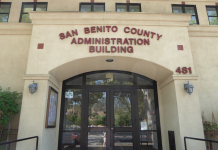Proposed rules to clean up Central Coast waters could damage
agriculture and put thousands of farmworkers out of work, according
to growers.
Proposed rules to clean up Central Coast waters could damage agriculture and put thousands of farmworkers out of work, according to growers.
But environmentalists say nitrates from fertilizers and pesticides are poisoning the region’s water supplies, and without more regulation, public health is at risk.
On Thursday, the Central Coast Regional Water Quality Review Board heard hours of testimony from both sides. Nearly 200 people packed the City Council chamber to participate in the discussion.
The board was to decide on new rules designed to protect drinking water supplies and aquatic habitat from agricultural runoff this month, but delayed a vote until February to give opposing sides time to hash out their differences.
“Everybody is in favor of clean water,” said Julie Engell, a Monterey County environmentalist. “The question is, what are we willing to do about it?”
Water-quality board staff proposes replacing voluntary programs with mandates to reduce, eliminate or treat agricultural runoff, monitor individual farming operations, and protect existing riparian buffers around crops or create new ones to act as natural filters.
Growers say in the past two decades they’ve taken steps to reduce pollution.
Strawberry growers, for instance, have moved away from water sprinklers to drip irrigation, which allows them to use less water and fertilizer since they can concentrate both on the plant’s roots. But, they say,
they’re being asked to clean up “legacy nitrates” left over from earlier generations that weren’t as sparing with water and fertilizer.
“I’m not doing the things my grandfather used to do,” said Erik Jertberg, a Pajaro Valley strawberry grower.
Nevertheless, Jertberg said that although the amount is much smaller than in the past, the salts from fertilizers build up near the roots, and he worries the new rules will mean he won’t be able to flush them farther away to protect the plants.
“This will stop strawberry production on the Central Coast,” Jertberg said.
Agricultural groups want more flexibility in the rules. A one-size-fits-all scheme won’t work given diverse crops, operations and conditions on the ground, they said.
Their proposal calls for farm operations to have plans in place to protect water quality and confidential and voluntary “SMART” monitoring designed to guide growers rather than penalize them.
Environmentalists in general support the rules proposed by the board’s staff, though some would like to see them more stringent.
Dipti Bhatragar, Northern California program director for the Environmental Justice Coalition for Water, told the board of the recent discovery of a contaminated well serving a farm labor camp in Pescadero.
According to an article in the San Mateo Times, a San Mateo County health official said nitrates in the Pescadero water were as high as 290 milligrams per liter, more than six times the federal standard.
“These are the people most vulnerable to contamination from nitrates,” Bhatragar told the board. “When you make your decision, I hope you will consider them.”










